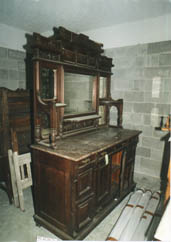Sideboard
Sideboard. Circa 1875-90. Wood, walnut and walnut veneer; poplar secondary wood; metal, brass hardware [Renaissance Revival style] Acc. No. 82.40.00.076
 Description: Carcass is set on double wheel casters with applied moldings around bottom. Shallow drawer center bottom has two cast bail pulls. Above this are two large doors with wood escutcheons on proper right door and metal lock on left. Frame and panel construction. Flanking the center compartment are two compartments with doors, one on top of the other and on each side of the center. Above this are three side by side shallow drawers with matching pulls. Central drawer is lined with purple felt cloth for silver flatware storage. Top of carcass has veined red and white marble surface. Elaborate top half of piece features three mirrored panels flanked on each end by display shelves set on arches and columns. There is an elaborate crest above with arched and pillared gallery and incised and shaped wood panels. A clear, natural resin varnish over the entire piece has darkened with age.
Description: Carcass is set on double wheel casters with applied moldings around bottom. Shallow drawer center bottom has two cast bail pulls. Above this are two large doors with wood escutcheons on proper right door and metal lock on left. Frame and panel construction. Flanking the center compartment are two compartments with doors, one on top of the other and on each side of the center. Above this are three side by side shallow drawers with matching pulls. Central drawer is lined with purple felt cloth for silver flatware storage. Top of carcass has veined red and white marble surface. Elaborate top half of piece features three mirrored panels flanked on each end by display shelves set on arches and columns. There is an elaborate crest above with arched and pillared gallery and incised and shaped wood panels. A clear, natural resin varnish over the entire piece has darkened with age.
Discussion: A fine example of the florid and elaborate Victorian style popular after the Civil War, this artifact once furnished the formal dining room of Florida Governor George Drew's mansion at Ellaville along the Suwannee River. Although the name Renaissance Revival might seem to refer to a form of calm classical design, this was an original Victorian style that really did not revive any historic style. While there were expensive and fashionable cabinet shops that custom designed and built furniture in this style, Governor Drew's sideboard was purchased from a factory and probably was designed by a now-anonymous shop foreman in imitation of the high-style pieces.
Bibliography
- Ketchum, William C. Furniture: Chests, Cupboards, Desks & Other Pieces (The Knopf
- Collectors' Guides to American Antiques). New York: Knopf, 1982. (See p. 301)


